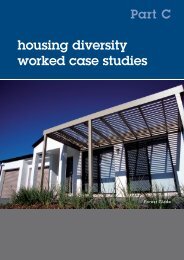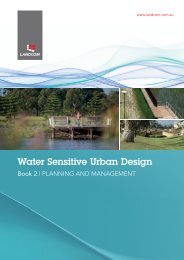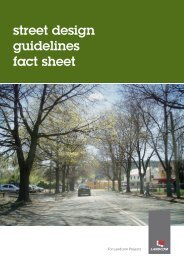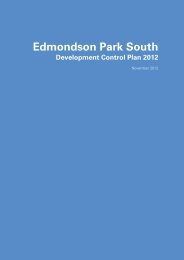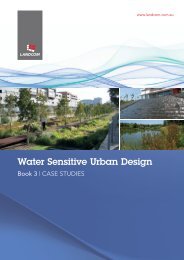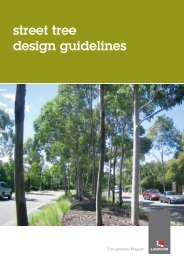Landcom Book 4 Maintenance - WSUD
Landcom Book 4 Maintenance - WSUD
Landcom Book 4 Maintenance - WSUD
You also want an ePaper? Increase the reach of your titles
YUMPU automatically turns print PDFs into web optimized ePapers that Google loves.
Water Sensitive Urban Design<br />
Item to be<br />
Monitored<br />
Purpose of<br />
Monitoring<br />
Performance<br />
Target<br />
Schedule<br />
<strong>Maintenance</strong> or<br />
Investigation<br />
Immediate<br />
Action Required<br />
<strong>Maintenance</strong><br />
Action Required<br />
Sediment<br />
build up<br />
The accumulation of sediment in the<br />
sediment forebay of the bioretention<br />
system is a prescribed function of<br />
this zone. However, sediment must be<br />
regularly removed to ensure that the<br />
sediment trapping performance of this<br />
zone is sustained.<br />
If sediment accumulates on the<br />
bioretention surface, percolation<br />
of water into the media may be<br />
reduced, resulting in poor treatment<br />
performance.<br />
Sediment absent<br />
Sediment<br />
accumulation<br />
appears excessive in<br />
sediment forebay<br />
Fine sediment<br />
accumulation<br />
apparent on<br />
bioretention media<br />
surface<br />
Sediment<br />
accumulated to half<br />
the forebay depth<br />
Coarse sediment<br />
or large volumes<br />
of sediment<br />
accumulation<br />
apparent on the<br />
bioretention media<br />
surface<br />
Schedule investigation to identify<br />
sediment source.<br />
Once sediment source is stabilised,<br />
remove accumulated sediment and<br />
replace the top 100 mm of filter media<br />
from the bioretention system. The filter<br />
media specifications should be as per<br />
the design intent.<br />
Common sense should be exercised<br />
in deciding if plantings need to be<br />
replaced as part of maintenance work.<br />
If the sediment build-up is extensive<br />
and smothering vegetation, it may be<br />
easier and less costly to remove the<br />
plantings and replant once the filter<br />
media has been replaced. Conversely,<br />
if the sediment build-up is small and<br />
isolated or the system is planted<br />
with trees, it may only be necessary<br />
to scrape away the accumulated<br />
sediment and the top 100mm of filter<br />
media and replace without disturbing<br />
the plants within the bioretention<br />
system.<br />
Lightly spread and compact replaced<br />
filter media using either hand tools, an<br />
excavator bucket or a pozitrack bobcat<br />
(DO NOT drive over the media with any<br />
vehicle but a pozitrack bobcat).<br />
Replace any damaged plants to meet<br />
the design plant schedule.<br />
Compaction<br />
Percolation into the media may be<br />
reduced if the media surface has been<br />
compacted, i.e. by pedestrian traffic,<br />
poor construction methods.<br />
No compaction<br />
evident<br />
Localised compaction<br />
or subsidence<br />
evident. Localised<br />
ponding longer than<br />
24 hours after storm<br />
event<br />
Water remains<br />
ponding longer than<br />
24hours after storm<br />
event<br />
Schedule investigation to identify<br />
cause of compaction.<br />
If compaction is localised, remove top<br />
500 mm of filter media with auger.<br />
- Break-up removed filter media so<br />
that it is no longer compacted.<br />
- Refill hole with uncompacted filter<br />
media (that is, there is no need to<br />
replace with new filter media).<br />
If compaction is extensive, seek expert<br />
advice.<br />
Weeds and<br />
invasive<br />
plants<br />
The growth of weeds can impair a<br />
bioretention system’s performance by<br />
- Changing flow paths across the<br />
bioretention system<br />
- Shading and out-competing plant<br />
species that are important for water<br />
treatment, or filter media stability.<br />
Weeds can spread to downstream<br />
environments, compromising<br />
ecosystem health.<br />
No weeds present Weeds present Noxious or<br />
environmental weeds<br />
present, or weed<br />
cover more than 25<br />
percent<br />
Hand removal or targeted herbicide<br />
treatment (herbicides registered for<br />
use around waterways).<br />
Note: Herbicides should not be<br />
routinely used to maintain edges and<br />
batter slopes. General spraying of<br />
batter slopes should not be undertaken<br />
without follow up revegetation with<br />
native species.<br />
Weeds compromise the visual amenity<br />
of the bioretention system.<br />
<strong>Book</strong> 4 | MAINTENANCE 25



